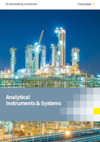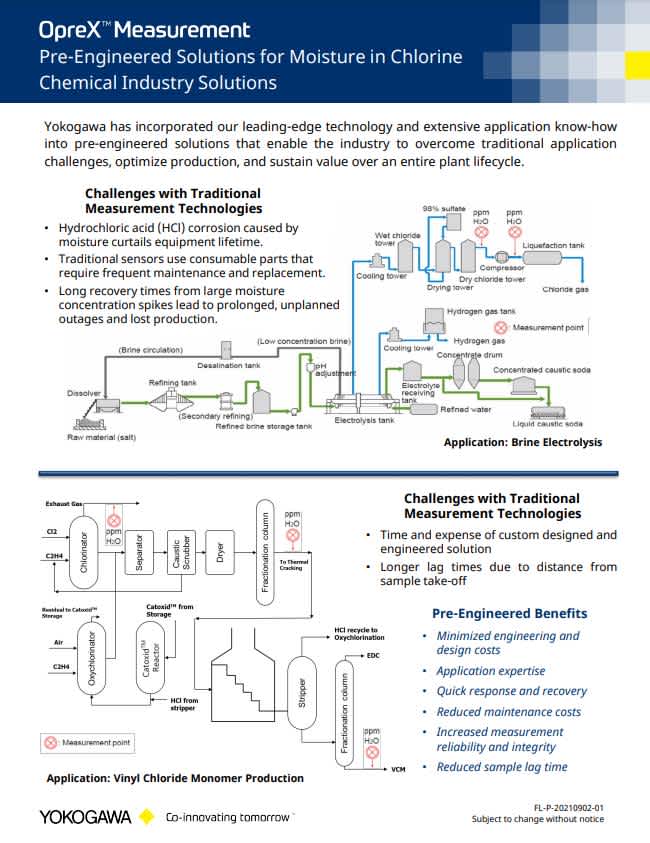YES - We Do That!
 Yokogawa Pre-Engineered Solutions
Yokogawa Pre-Engineered Solutions
Yokogawa’s leading-edge technology and extensive application know-how enable partnerships with customers in developing YES to optimize processes and sustain value over the entire plant lifecycle. Along with being one of the longest operating analytical system integrators, Yokogawa is recognized globally for process analytical project execution excellence and analytical subject matter expert.… Begin your transformation journey.
Analyzer Integration Challenges
 |
 |
 |
|
The engineering and design process is convoluted with increased costs associated with complex engineering and frequent design changes requiring the need for a pre-engineered solution. |
Designed solutions are often over-complicated with inconsistent engineering, design, and execution from project to project compounding the need for a streamlined packaged solution |
From design, to quote, to delivery and install the project timeline is often hindered by scope creep, miscommunication, overlooked expenses, and missed deadlines that can be addressed upfront with pre-engineered solutions. |
YES - Does That. Proven Designs. Quick Installation.
When addressing a standardized solution that has applications across multiple sites or processes, Yokogawa Pre-Engineered Solutions (YES) significantly reduces both the engineering and design costs to the customer. In addition, these solutions greatly reduce the execution cycle as they are quicker to quote, quicker to document submittals, and thus, quicker to get your process running smoothly again.
|
|
|
|
|
Reduced costs for engineering man-hours and procurement by implementing proven application expertise. |
Standardized solutions across multiple sites/process units to improve maintenance and operational work efficiency. |
Speed up project execution cycle times with drop-in, turnkey standardize solutions. |
Details
Moisture in Chlorine Measurement
 CHALLENGE
CHALLENGE
Moisture breakthroughs can cause the formation of HCl, which will cause corrosion of process pipes and reduce equipment lifetime creating unplanned outages and reducing overall process safety.
- Traditional sensors require frequent maintenance and replacement due to consumable parts.
- Traditional sensors recovery time from large concentration spikes of moisture can take more than 24 hrs causing process shutdown.
YES - SOLUTION
The standardized design based on application expertise shortens project execution time and minimizes engineering and design costs to provide repeatable, reliable measurements, quicker response, and recovery time. Our application expertise eliminates any design uncertainties, increases measurement integrity and reliability, and eliminates additional installation and maintenance costs.
HOW IT WORKS
- Complete the simple customer data sheet to provide moisture range, analysis range, process pressure, process temperature, ambient temperature, and return pressure.
- Contact us for a quick turnaround quotation and simple drawing package.
- By standardizing on a proven successful design, the project execution time is shortened while simplifying the maintenance time by having standardized solution designs throughout the application locations and plant sites.
SPECIFICATIONS

| Ambient Temperature | -13 to 140ºF |
|---|---|
| Process Supply Pressure | 0 to 100 psig |
| Process Supply Temperature | 50 to 131ºF |
| Process Return Pressure | 0 to 80 psig |
| Sample Transport Bundles | By Yokogawa, By Others |
| Sample Transport Tubing Material | Monel, Hastelloy C |
| Sample Handling System Materials | Monel, Hastelloy C |
| Nitrogen Dryers | Single, Dual |
| Communication | Ethernet, Fiber |
| Hazardous Area Classification | Class I, Division 2, Group BC&D, T3 |
Ambient Air Monitoring of "Fugitive Gas Emissions"
 CHALLENGE
CHALLENGE
There are numerous gases found in industrial process plants that are harmful should a gas leak occur, such as dioxide, hydrogen sulfide, vinyl chloride monomer (VCM), benzene, 1,3-butadiene, and others
- Traditional systems have a limited number of sample/monitored points per system.
- Traditional systems are time-consuming and have complicated manual reporting
YES - SOLUTION

The Yokogawa ambient air system is paired with the SMARTDAQ+ data recorder, simplifying data collection, and custom reporting for concentration values on daily, weekly monthly, or other user-specified time intervals.
The standardized design based on application expertise shortens project execution time and minimizes engineering and design costs to provide repeatable, reliable measurements, quicker response, and recovery time. Our application expertise eliminates any design uncertainties, increases measurement integrity and reliability, and eliminates additional installation and maintenance costs.
HOW IT WORKS
- Complete the simple customer datasheet to provide moisture range, analysis range, process pressure, process temperature, ambient temperature, and return pressure.
- Contact us for a quick turnaround quotation and simple drawing package.
- By standardizing on a proven successful design, the project execution time is shortened while simplifying the maintenance time by having standardized solution designs throughout the application locations and plant sites.
- Can be modified for other gas area monitoring as well. Contact us to discuss further
SPECIFICATIONS

| Ambient Temperature | -40 to 140ºF |
|---|---|
| Benzene Analysis Range | 0 to 1 ppb |
| VCM Analysis Range | 0 to 20 ppm |
| EDC Analysis Range | 0 to 50 mol% |
| Stream Count | Up to 15 |
| Stream Length | User-Defined |
| Sample Transport Bundles | By Yokogawa, By Others |
| 3-Sided Shelter | Included or Not Included |
| Instrument Air Filters | Single, Dual, None |
| Communication | Ethernet, Fiber |
| Hazardous Area Classification | Class I, Division 2, Group BC&D, T3 |
Resources
Electrolysis plants create hydrogen and chlorine from a brine solution. Chlorine gas generated from the anolyte of the electrolysis tank generally contains between 0.5 to 2.0 vol% H2O. The sample is then cooled and filtered to remove brine, subsequently coming out as wet chlorine gas. The wet gas is sent to a drying tower where it is treated with sulfuric acid to get moisture down to the ppm level.
Downloads
Brochures
Forms
Looking for more information on our people, technology and solutions?
Contact Us










